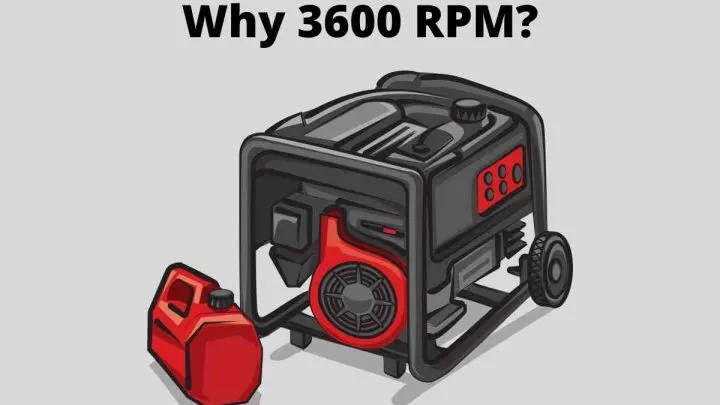Generators are often necessary for emergencies or in remote locations where connection to a regular electricity supply is impossible. They work by rotating an internal element to produce electricity, but you may have wondered why generators run at a very specific rate of 3,600 revolutions per minute, or RPM.
Generators run at 3,600 RPM to match the required frequency of 60Hz of the North American power grid. The generator rotates an internal magnetic element around a copper wire to generate the electrical current needed for electrical appliances to operate in North America.
This article will look further into the science behind generator rotation speeds. We’ll discuss why the speeds are significant and how generators work to produce electricity. We’ll also cover the importance of frequency and the relationship between Hertz and RPM.
How Generators Produce Electricity
A generator produces electricity by converting one form of energy into electrical energy.
This energy is taken from a fuel source which the generator uses to turn a magnet around a wire, which pushes electrons through the wire resulting in an electrical current (source).
This principle goes back to the scientist William Faraday who discovered the properties of electric motors and has changed little since then.
Generating Electrical Current
In this case, the burning of the fuel, whatever fuel you use to power your home or portable generator, produces energy used to turn the interior magnet. The poles of the magnet are positioned at either side of a wire, usually copper, as this is an effective conductor for electricity.
The alternating positive and negative poles of the magnet exact force on the wire, in the same way magnets can push or attract metal objects depending on what side you use. By quickly alternating between positive and negative poles, the magnet’s force pushes electrons through the copper wire.
The principle is the same in both large power plants and small generators. By burning fuel, a magnet is rotated, and the speed of this rotation is described as revolutions per minute, or RPM.
The Required Power Output From a Generator
In North America, the power grid is regulated to operate at a frequency of 60 cycles per second, or hertz (Hz). To achieve this, generators are fitted with a feature called a ‘governor,’ which keeps the rotating element spinning at the correct rate.
The speed a standard generator is set to spin at to achieve 60 Hz is 3,600 RPM, but what exactly is the reason for this?
The Relationship Between RPM and Hertz
Knowing that RPM stands for revolutions per minute, we can divide 3,600 RPM by 60 (the number of seconds in a minute) to get 60 revolutions per second, matching the Hertz requirement.
Remember, the rotating element of the generator is magnetic. A standard generator will consist of a ‘2 pole’ magnet, one positive and one negative pole, both at opposite sides of the wire where the electrical current is generated.
If the number of poles increases, you can decrease the revolutions per minute as there is a greater magnetic force within the generator, as shown in the table below.
| Poles | RPM | Hz |
| 2 | 3,600 | 60 |
| 4 | 1,800 | 60 |
| 6 | 1,200 | 60 |
Most generators operate with either 1,800 or 3,600 RPM. 1,800 RPM generators are more fuel-efficient than 3,600 RPM models, as their lower rate of revolution requires a lower use of fuel to achieve, but they will also cost more money to purchase.
Therefore, the 3,600 RPM generator remains one of the most commonly used in the United States and Canada.
Why Generators Operate at 60Hz
The reasons for the 60 Hz frequency in North America go back many years, to the period when electricity was being rolled out gradually worldwide.
In most other parts of the world, the frequency of electric current used is 50 Hz. This followed a period of significant variance in frequencies to match the different power generation designs and methods of the time. As companies standardized across countries and continents, both Europe and North America settled on different frequencies (source).
Advantages of the 60Hz Frequency
Although electrical systems in North America are designed to operate at 60Hz, no practical difference exists between a 60 Hz and 50 Hz system. There are no specific advantages or disadvantages, and the only reason for the differences is based on which frequency early manufacturers prefer.
When running at 60 Hz, there’s an increase in power in terms of voltage, but this has no real impact to the operation of appliances, and you wouldn’t notice any difference between one running at 50 Hz and another at 60 Hz (source).
Can I Convert Between 50Hz and 60Hz?
You can convert between 50 Hz and 60 Hz. However, limited situations for the purposes of a generator that’s designed for backup power or use outdoors will require this, especially if you’re only plugging in standard household appliances and fixtures.
Conversion typically is needed only to allow specific electrical engineering equipment to run where the power supply uses a different frequency.
Conclusions
Generators run at 3,600 RPM to ensure that they are able to produce electrical current at a suitable frequency for the United States and Canada power grid. This required frequency is 60 Hz.
You can also use generators that operate at 1,800 RPM to achieve a frequency of 60 Hz on fuel in the long run.
If you’re outside North America, then you’ll likely require a generator with a different RPM as most other countries use a frequency of 50 Hz in their power grids. If you’re in doubt, check the requirements where you live.
Recommended Reading

